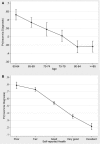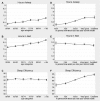Insomnia Disorder Among Older Veterans: Results of a Postal Survey
- PMID: 30952212
- PMCID: PMC6457506
- DOI: 10.5664/jcsm.7710
Insomnia Disorder Among Older Veterans: Results of a Postal Survey
Abstract
Study objectives: To estimate the prevalence of insomnia disorder among older veterans and to study relationships among age and self-rated health, with insomnia disorder, self-reported sleep duration and sleep efficiency.
Methods: A cross-sectional postal survey of community-dwelling older veterans (older than 60 years) seen at one VA Healthcare System in the prior 18 months was performed, which was constructed to align with the general diagnostic criteria for insomnia disorder (International Classification of Sleep Disorders, Second Edition [ICSD-2]). The survey also queried self-reported sleep duration, bedtime, and wake time, which were used to calculate sleep efficiency. The survey also asked about race/ethnicity and self-rated health (using the general health item from the Short Form-36).
Results: A completed survey was returned by 4,717 individuals (51.9% response rate; mean age 74.1 years). Of those, 2,249 (47.7%) met ICSD-2 diagnostic criteria for insomnia disorder. In logistic regression analyses, insomnia disorder was more likely among younger age categories (odds ratios [OR] 1.4-2.5) and in those with worse self-rated health (OR 2.1-14.4). Both total nocturnal sleep time and time in bed increased with older age (all P < .001), whereas sleep efficiency did not differ. Worse self-rated health was associated with shorter total nocturnal sleep time, more time in bed, and lower (worse) sleep efficiency.
Conclusions: Results of the postal survey suggest that almost half of community-dwelling older veterans have insomnia disorder, which was more common in young-old and among those with worse self-rated health. Additional work is needed to address the high burden of insomnia among older adults, including those with poor health.
Keywords: aging; insomnia; self-rated health; survey study.
© 2019 American Academy of Sleep Medicine.
Figures


References
-
- Lichstein KL, Durrence HH, Riedel BW, Taylor DJ, Bush AJ. Epidemiology of Sleep: Age, Gender and Ethnicity. Mahwah, NJ: Lawrence Erlbaum Associates, Inc.; 2004.
-
- Ancoli-Israel S, Roth T. Characteristics of insomnia in the United States: Results of the 1991 National Sleep Foundation survey. Sleep. 1999;22(Suppl 2):S347–S353. - PubMed
-
- Ohayon MM. Epidemiology of insomnia: what we know and what we still need to learn. Sleep Med Rev. 2002;6(2):97–111. - PubMed
-
- Ohayon MM, Roth T. Place of chronic insomnia in the course of depressive and anxiety disorders. J Psychiatr Res. 2003;37(1):9–15. - PubMed

